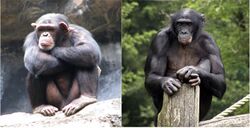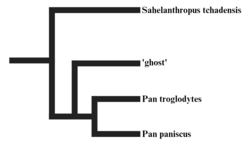Biology:Panina
| Panina | |
|---|---|

| |
| A male Chimpanzee (left) and a male bonobo (right) | |

| |
| Phylogeny of Panina including the ghost lineage and Sahelanthropus. | |
| Scientific classification | |
| Domain: | Eukaryota |
| Kingdom: | Animalia |
| Phylum: | Chordata |
| Class: | Mammalia |
| Order: | Primates |
| Suborder: | Haplorhini |
| Infraorder: | Simiiformes |
| Family: | Hominidae |
| Subfamily: | Homininae |
| Tribe: | Hominini |
| Subtribe: | Panina Delson, 1977[1] |
| Type genus | |
| Pan Blumenbach, 1775
| |
| Genera | |
Panina[2] is a subtribe of Hominini comprising all descendants of the human-chimpanzee last common ancestor (LCA) that are not a part of the human lineage; that is, all ancestors of the type genus, Pan (chimpanzees and bonobos).[3][1] The split occurred around 6-8 mya.[4] Fossils from this subtribe are typically rare because they tend to live in environments with poor fossilization. Some of the earliest chimpanzee fossils are 500,000 years of age.[5]
Classification
Hominini is typically subdivided into two subtribes: the Australopithecina/Hominina and Panina. The genus Sahelanthropus lived around the time of the divergence, and may have been a member of either lineage, a precursor to both lineages, or possibly a member of Gorillini. Regardless, the morphology of S. tchadensis supports the theory that hominins at and after the divergence are unlikely to resemble their derived descendants in appearance.[6][7] A genetic study conducted in 2010 surveyed chimpanzee Mitochondrial genomes and discovered the presence of an extinct ghost lineage of Panina that diverged around 3.3 mya and began interbreeding with bonobos, who then interbred with chimpanzees. This signature is carried more heavily in P. troglodytes despite having interbred with bonobos first, seeing as how they occupy a greater range.[8]
See also
References
- ↑ 1.0 1.1 Delson, Eric (1977). "Catarrhine phylogeny and classification: Principles, methods and comments". Journal of Human Evolution 6 (5): 433–459. doi:10.1016/S0047-2484(77)80057-2.
- ↑ Panina at Fossilworks.org
- ↑ Harrison, T. (2010), "Dendropithecoidea, Proconsuloidea, and Hominoidea", Cenozoic Mammals of Africa, pp. 429–470, doi:10.1525/california/9780520257214.003.0024, ISBN 9780520257214, https://academic.oup.com/california-scholarship-online/book/15282/chapter-abstract/169819774?redirectedFrom=fulltext
- ↑ Dolhinow, Phyllis; Sarich, Vincent (1971). Background for Man. Little, Brown & Co.. p. 76. ISBN 9780512246967. https://books.google.com/books?id=FvDpJ2ulVSUC.
- ↑ Hopkin, M. (2005), "First chimp fossil unearthed", Nature, doi:10.1038/news050829-10, https://www.nature.com/articles/news050829-10
- ↑ Guy, F.; Lieberman, D.E.; Pilbeam, D. et al. (2005). "Morphological affinities of the Sahelanthropus tchadensis (Late Miocene hominid from Chad) cranium". PNAS 102 (52): 18836–18841. doi:10.1073/pnas.0509564102. PMID 16380424. Bibcode: 2005PNAS..10218836G.
- ↑ Wolpoff, M. H.; Hawks, J.; Senut, B. et al. (2006). "An Ape or the Ape : Is the Toumaï Cranium TM 266 a Hominid?". PaleoAnthropology 2006: 36–50. http://www.paleoanthro.org/journal/content/PA20060036.pdf.
- ↑ Bjork, Adam; Liu, Weimin; Wertheim, Joel O.; Hahn, Beatrice H.; Worobey, Michael (2011), "Evolutionary History of Chimpanzees Inferred from Complete Mitochondrial Genomes", Molecular Biology and Evolution 28: 615–623, doi:10.1093/molbev/msq227, PMID 20802239, PMC 3108604, https://academic.oup.com/mbe/article/28/1/615/984161?login=false
Wikidata ☰ Q3305022 entry
 |


